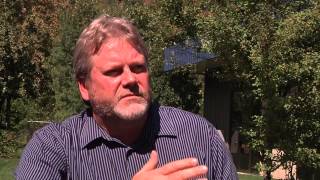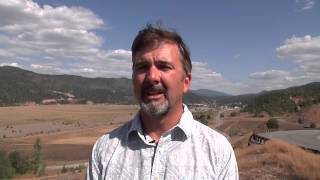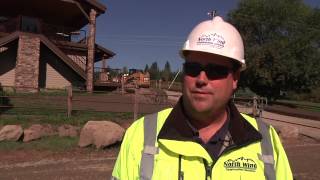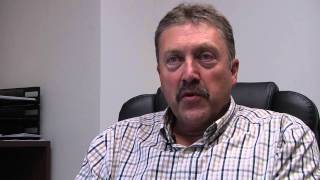[two_third]
When you live in Idaho’s Silver Valley, toughness comes with the territory. For more than 100 years , the men of this region drilled into the hard rock valley walls some of the deepest and richest underground silver mines the world has ever known.
“The first year I started working in the mine I put on 45 pounds,” said Jim McReynolds, now the director of the Wallace District Mining Museum. “Not a single ounce was fat.”
While some mines remain in operation, most have long since closed. The giant smelter that spit more than 100 million tons of toxic metals into the air above the city of Kellogg closed in the 1980s. The skeletal remains of the silver boom are littered throughout the valley.
Residents of Kellogg, Wallace and other communities along the I-90 corridor proudly reflect on the region’s mining heritage. But confronting the legacy left by that industry requires a toughness every bit as challenging as muscling a jackleg drill 5,000 feet underground. [/two_third] [one_third last] [/one_third] [clear]
[two_third]
Scarred environment, collapsed economy
Along the main drag in the city of Kellogg, there is an eerie stillness broken only by an occasional passing car. Several businesses are boarded up. For sale and for rent signs are unusually abundant. The population is down a third from what it was in 1980—before most of the silver mines closed.
Photo by Jason Moore
Just west of Kellogg sits a massive 220-acre pile of mine tailings, remnants of the valley’s largest mine, the Bunker Hill Mine. The waste rock is loaded with metals—lead, cadmium, arsenic and zinc—that dissolve into the groundwater and drain into the South Fork of the Coeur d’Alene River. The soils surrounding Kellogg remain contaminated with lead from the tailings and smelter operation. Thirty years after the smelter closed, some hillsides still refuse to support vegetation following decades of acid rain.
Alarmingly high lead levels detected in area children finally prompted the federal government to intervene. In 1983, the U.S. Environmental Protection Agency declared the area around Kellogg and the Bunker Hill Mine a Superfund site, adding it to the National Priorities List of abandoned hazardous waste sites. It was later expanded to encompass the entire 45-mile valley and South Fork watershed, home to more than 300 mines and a mind-boggling clean up effort.
Enter North Wind Construction. [/two_third]
[one_third last]
What is a Superfund?
Superfund is the name given to the environmental program established to address abandoned hazardous waste sites. It allows the EPA to clean up such sites and to compel responsible parties to perform cleanups or reimburse the government for EPA-lead cleanups.
[/one_third] [clear]
Silver Valley, Idaho
[one_fifth] [/one_fifth] [three_fifth]
Growing to meet demand
CIRI subsidiary North Wind Construction set up shop in the Silver Valley 11 years ago after securing a contract to help with the clean up. At that time the company had three employees based at its office along Big Creek Road, less than a mile from the legendary Sunshine Mine just east of Kellogg. The Sunshine Mine was once recognized as one of the world’s most profitable silver mines, but it also carries the unshakable stigma as the site of one of the worst mining disasters in American history. In 1972, a fire at the mine claimed the lives of 91 miners who suffocated more than 3,000 feet underground.
After living in the Silver Valley for nearly two decades, North Wind Construction President Kevin Redmond is familiar with navigating the sensitivities of local residents who, despite the massive contamination, fondly refer to the Bunker Hill Mine as “Uncle Bunker,” and blame the EPA and federal government for sapping their former lifestyle.
“It’s a very close-knit community; outsiders are really not welcome,” Redmond said. “I’ve lived here for 17 years, and it took about half of those years to really feel comfortable here.”
Now with 53 employees, North Wind Construction has grown to become one of the valley’s major contractors helping with the clean up. North Wind manages four large repositories for waste rock. On any given day, the pace at the repositories is constant. Large dump trucks collect contaminated mine tailings from throughout the valley and arrive every few minutes to dump their loads. Every few minutes another load. Every day. Millions of cubic yards of waste have accumulated at the repositories with the goal to consolidate and manage it more effectively to reduce human health risks and improve water quality.
Photo by Jason Moore
The scope of the contamination is difficult to comprehend. Not only does it come from piles of mine tailings; over the years, the contaminated rock was used as property fill and in the construction of roads. The finer tailings were used to sand icy roads in the winter. Flood waters carried the waste all the way to Lake Coeur d’Alene 40 miles away. The contamination is everywhere.
North Wind also oversees a program for the Idaho Department of Environmental Quality, which tests private property for contamination. If the soil exceeds safe lead levels, contactors will scoop off the top foot of contaminated earth and replace it with clean soil at no cost to the homeowner or business. The contaminated waste is hauled to the repositories. More than 6,000 properties have already been remediated. [/three_fifth]
[one_fifth last]
The CIRI Connection
North Wind Construction is a subsidiary of Cook Inlet Region, Inc. (CIRI), an Alaska Native corporation based in Anchorage, Alaska. CIRI represents more than 8,400 shareholders primarily of Alaska Native decent. To learn more about CIRI businesses, click here.
[/one_fifth] [clear]
[one_third]
East Fork Ninemile Waste Consolidation Area
- 20 acres
- Located seven miles north of Wallace, Idaho
- 200 dump truck loads/day
- Appx. 6,000 tons of tailings moved each day
- Tailings are from:
- Interstate-Callahan Mine
- Tamarack Mine
- Success Mine
- Primary contaminants:
- Zinc
- Lead
- Cadmium
- Arsenic
- WCA Capacity: 1.3-1.5 Million cubic yards of waste
- Ninemile Creek clean up expected to take 8-12 years
[/one_third] [two_third last]
Moving Mountains
In 2009, a settlement with the ASARCO mining and smelting company provided $436 million dollars for clean up in the Silver Valley. To handle the funds, the Coeur d’Alene Trust was established, and with the help of North Wind Construction, has created one of the most ambitious projects yet: the East Fork Ninemile Waste Consolidation Area.
Just getting to the site near the headwaters of Ninemile Creek is a challenge. From the town of Wallace you head north, following old logging roads past soaring piles of tailings from long-defunct mining operations, you climb steep pitches with switchbacks that encourage you not to look down or contemplate the consequences of a wrong turn. Eventually, you reach a construction site larger than many of the small towns in the Silver Valley.
The Ninemile Waste Consolidation Area is a 20-acre patch of land high in the mountains that has been blasted and contoured to handle the contaminated waste rock from several mines lower in the drainage.
North Wind Construction built the site and now manages it. Ear-splitting diesel engines operate at a furious pace. Massive dump trucks large enough to haul a small house bring tailings, to the tune of 200 loads a day, from the mine sites, while bulldozers spread it out. This heavy equipment choreography started this year and will continue for another eight years until the site is considered full and capped to reduce runoff concerns. It will become, literally, a mountain of mine waste, returning the tailings to where they came from, deep underground.
The Coeur d’Alene Trust expects to spend about $20 million a year on clean up efforts. Managed like an endowment, the Trust is hopeful the settlement funds can extend 20 years or longer, with the knowledge that clean-up needs far exceed even the large amount of the settlement.
“The goal is to earn more money than we spend, which is currently what we’re doing because we’re in an up market,” said Dan Meyer of the Coeur d’Alene Trust, who spent the previous 30 years working for the mines. “The Trust currently has $100 million more than what we started with.”
The primary purpose of the ambitious project is to eliminate a major source of metal contamination in the South Fork of the Coeur d’Alene River, which remains nearly devoid of aquatic life.
“We’re trying to get it [the contamination] at its source,” said Ed Moreen, project manager for the Environmental Protection Agency. “Particularly, dissolved zinc is harmful to the macroinvertebrates, which fish live on. It’s also harmful to the fish themselves.” [/two_third] [clear]
Silver Valley Perspectives
[raw]
[one_third]
[/one_third]
[one_third]
[/one_third]
[one_third last]
[/one_third]
[clear]
[/raw]
[one_third]
[/one_third] [two_third last]
Patient Progress
Despite the sheer enormity of the problem, there are indications the Silver Valley is coming back.
“I remember years ago driving through the valley and thinking, My goodness, a bomb went off in this place,” said North Wind’s Kevin Redmond. “Just in the 17 years I’ve been here, I’ve seen noticeable improvements. Lots more vegetation, all the residential and commercial properties getting re-landscaped, and so it’s nice to be part of it.”
The hills that rise south of Kellogg used to look like a barren wasteland. As late as 1995, there were no trees and no vegetation. The mines harvested the trees for use underground, and the sulfuric acid from the smelter took care of the rest. But you wouldn’t know that today. An aggressive re-planting effort by the mine and soil treatments by the EPA has led to a forest with 30-foot-high white pine trees covering the slopes.
“It’s interesting to see people come back for 15-, 20-, 25-year reunions, and they can’t believe it’s the same place,” said Kevin Yrjana, a project manager with North Wind Construction who grew up in Kellogg and spent time in the mines. “Our barren hillsides are now painted green with pine trees and brush and grass that a lot of folks thought you’d never see in the Silver Valley.”
The children of Kellogg, who regularly receive blood tests, no longer show dangerously high lead levels in their systems. Most of the properties in the city have taken advantage of the soil remediation around their homes. And the EPA is aggressively funding a program to repave the roads in the area, hauling the contaminated asphalt to the repositories.
The South Fork of the Coeur d’Alene River remains a concern, but it, too, has come a long way.
“I can remember as a kid coming up to the valley, you stayed out of the South Fork. It was called Lead Creek,” recalls Dan Meyer of the Coeur d’Alene Trust. “The tailings from the mine used to dump directly into the South Fork and it ran kind of a milky gray color. Just thick.”
The waters are clear today but still test high for metal contamination, which remains a primary focus of the EPA and the Coeur d’Alene Trust. The two major contributors to the contamination are Ninemile Creek, which is being addressed by the new Waste Consolidation Area that North Wind built, and the 220-acre tailings pile just west of Kellogg known as the Central Impoundment Area.
“There’s large-scale groundwater moving off the South Fork of the Coeur d’Alene River in the city of Kellogg,” said EPA’s Ed Moreen. “It runs underneath the town of Kellogg, then under the Central Impoundment Area, before it rejoins the river. It’s the number one loader of zinc and cadmium to the South Fork.”
The agency’s next big project is to install a series of groundwater wells below the Central Impoundment Area and pump the contaminated water to a renovated water treatment facility before discharging the clean water into the river. Plans are already in the works to expand the capacity of its current treatment facility in Kellogg.
Still, many residents in the communities of Kellogg, Wallace and others hesitate to embrace the clean up efforts. Many still cling to the way of life they used to know—easy-to-find jobs in the brute, underground world that defined this valley for a century.
Kevin Yrjana has his own theory about the attitude in the valley. “It’s a generational thing,” he says. “The mining lifestyle was ingrained in these people for so long, it will take a younger generation who sees the world differently to be able to embrace what becomes the next chapter for the Silver Valley.”
Meanwhile, Kevin Redmond knows that with each hire the attitude will slowly change. Ninety percent of North Wind Construction’s employees are local residents. Between the EPA, the Coeur d’Alene Trust, the Idaho Department of Environmental Quality and others, the clean-up efforts bring more than $30 million a year to the Silver Valley. This boon is expected to continue for the next 20 years and likely much longer.
“Uncle Bunker” left town more than 30 years ago. The mining companies carted off an estimated $6 billion in metals from this valley, largely due to the gritty toughness of the local residents who chose to endure the hardships that most would not begin to consider. But today, the residents continue to confront what is perhaps their toughest challenge yet: change. [/two_third] [clear]
Photo Gallery
[smart-grid captions_color=”#666″ font_size=”12px” font_weight=”100″ font_color=”#fff” lightbox=”magnific-popup” title=”true”]
[/smart-grid]










